Versión en español más abajo
Greetings community!
It's nice to share with you again. I have wanted to share with you some more of my memories. But, this new collection that I will be presenting to you is a little different.
I present to you our collection of Venezuelan banknotes
Although a banknote is something of great use by society, it usually changes so much and so fast that the only way to see them again is in a museum or some private collections.
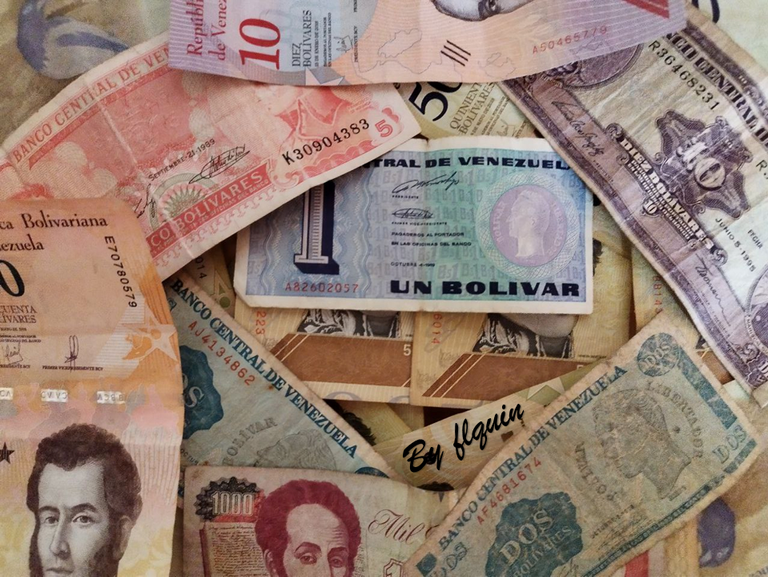
Well, having a collection of banknotes can be relatively easy. In our case, it has only been enough to take some from routine use, avoid its purpose, for example, not to use it on a bus ticket, in a purchase at the market or to avoid paying with it some service and just keep it with others.
Perhaps the only drawback of trying to build a collection like this would be trying to get bills that you never got to use, bills that had very little issue, special edition bills, or because of age. For example, the first banknote dated in Venezuela is from 1811 the so-called "Asignados" or the mirandino banknote in honor of Francisco de Miranda who suggested the idea to the recent Venezuelan congress established to give a certain economic order to Venezuela that was living a revolutionary awakening. To get such a banknote, no doubt, must be something extremely difficult and not within the reach of everyone.
However, I think you will find it particularly interesting the amount of banknotes that my country has had in such a short period of approximately 20 years (not including the banknotes of the current monetary cone in force since October 2021).
Saying this, I want to make it clear that this collection, although I would like to present it completely, I think it is better to divide it into several parts, to make it more enjoyable and to be able to analyze in detail each banknote. Today I will be presenting the first banknotes that were stored and next week I will be presenting the rest of the collection.
When I refer to the monetary cone, I am referring to all those banknotes that are or were in circulation in a society. For example, the well-known bills and coins of the United States, which transcend borders that we know with the denominations of 1, 2, 5, 10, 20, 50, and 100 USD represent the current monetary cone of the United States.
I don't want to talk about political details or anything like that. The reason for the existence of so many monetary cones in Venezuela has to do with the superinflation that this country has experienced. In short, inflation occurs when the price of products and services increases in the deterioration of the currency. This translates into a decrease in the purchasing power of money.
Venezuela's currency is the Bolívar in honor of Simón José Antonio de la Santísima Trinidad Bolívar Ponte y Palacios Blanco (Simón Bolívar), one of the most important heroes who influenced the independence process of Venezuela and some other countries in South and Central America. The bolivar as currency was established in 1879 only in Venezuela.
Although they are not the first banknotes that Venezuela had, they are the first two banknotes in this collection, which I remember using. But, they have a very peculiar history, they are the 1 and 2 bolivar bills.
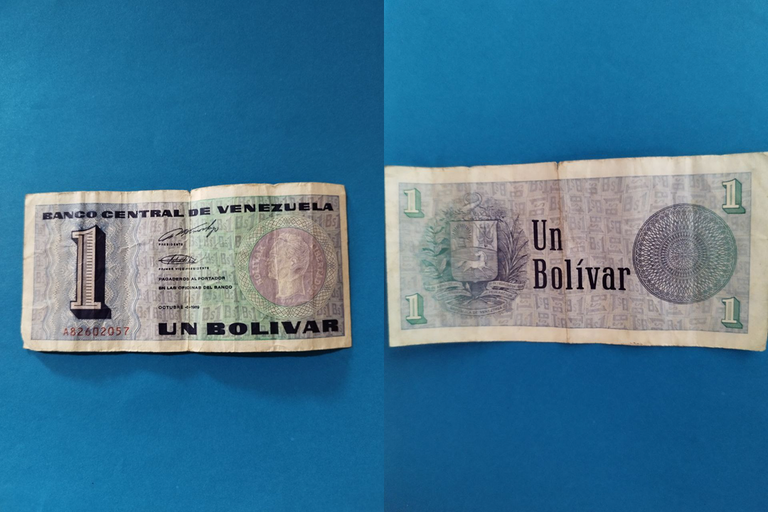
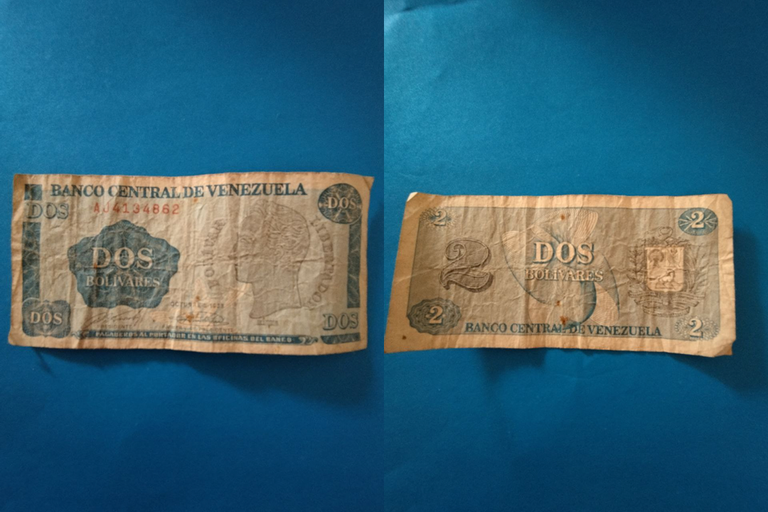

These bills became known as "Tinoquitos" after the current president of the time (Pedro Tinoco) and because of the simplicity they showed, they were also known as "Billetes de Monopolio" (Monopoly Bills) after the famous game. They appeared in the Venezuelan economy almost as an emergency in 1989. The Venezuelan economy, being rich in minerals, made the mistake of adding too much Nickel to the composition of the currency, which made them more valuable than they were. Venezuela's neighbors undertook a campaign to take these valuable coins and use them in their industry. Since there was a shortage of coins, the decision was made to give light to these banknotes. There were several such valuable coins in the history of Venezuela.
The first cone I dealt with as a child was the one that lasted the longest. There were coins and bills of a fairly low denomination with which you could do quite a bit. Although there were coins, in this post I will only introduce you to the bills we kept. Maybe later, I will show you the coins we own.
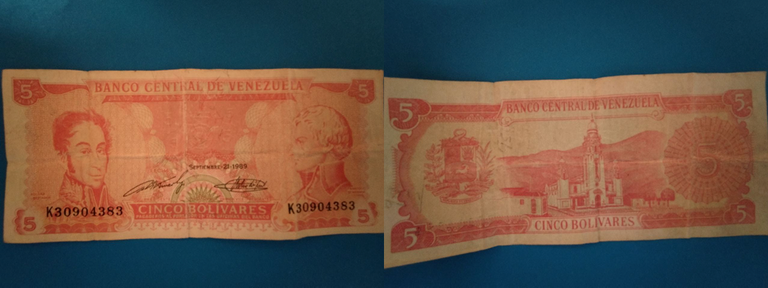
You can see Simón Bolívar and Francisco de Miranda on the back is the National Pantheon with the Venezuelan coat of arms.
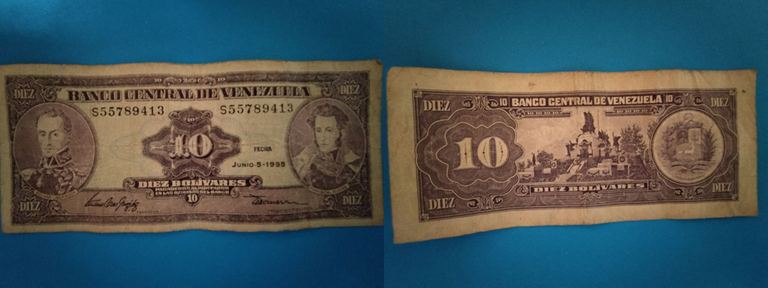
10 bolívares show Simón Bolívar and Antonio José de Sucre on one side of the bill and the National Pantheon and the Venezuelan coat of arms on the other side.
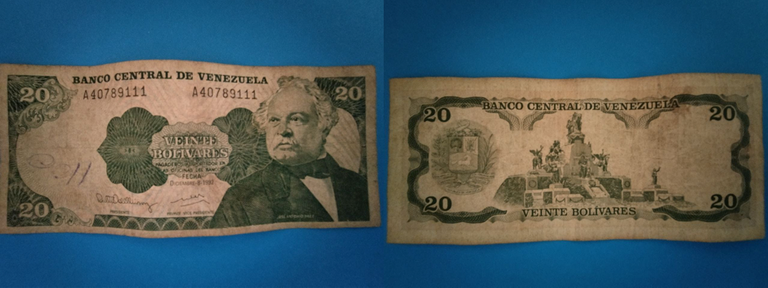
20 bolívares is the figure of José Antonio Páez, the monument of the National Pantheon and the coat of arms.
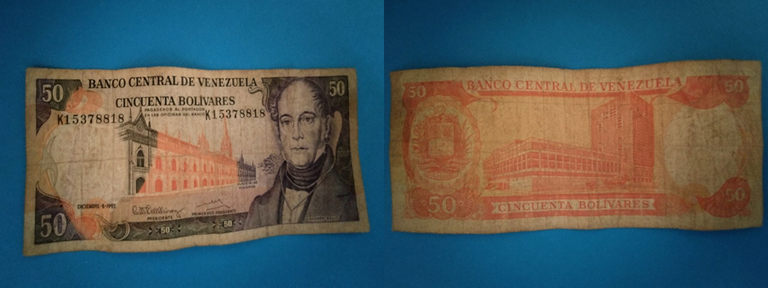
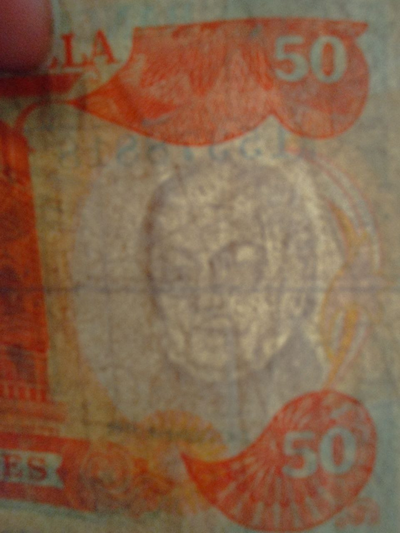
50 bolivares shows the figure of Andrés Bello next to the Palacio de las Academias, on the back is the Central Bank and the coat of arms.
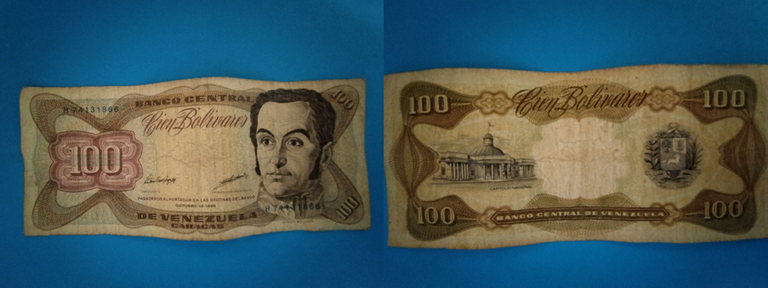
100 bolívares, with the face of Simón Bolívar and the National Capitol and the national coat of arms on the back.

500 bolívares has the face of Simón Bolívar, an orchid, and the national coat of arms on the back.
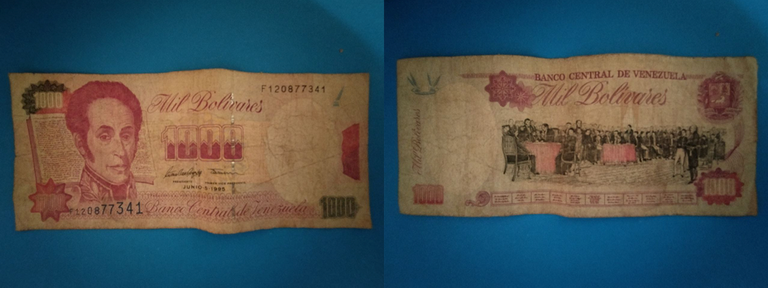
1000 bolivars have the face of Simón Bolivar and on the back a historical moment (the Signing of the Act of Independence, July 5, 1811).

1000 bolívares has the face of Simón Bolívar and the back shows the National Pantheon and the national coat of arms.
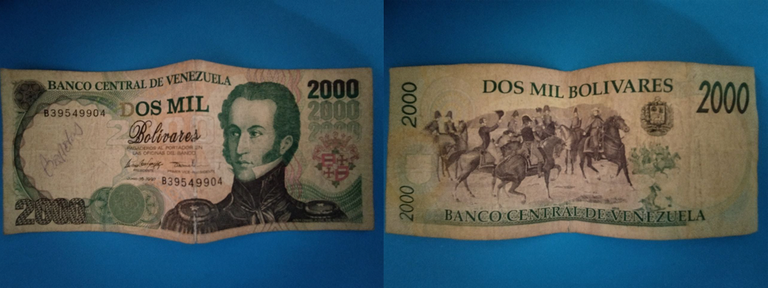
2000 bolivares shows the face of Antonio José de Sucre and the Triumph of Sucre at the Battle of Ayacucho (December 9, 1824) and the national coat of arms.
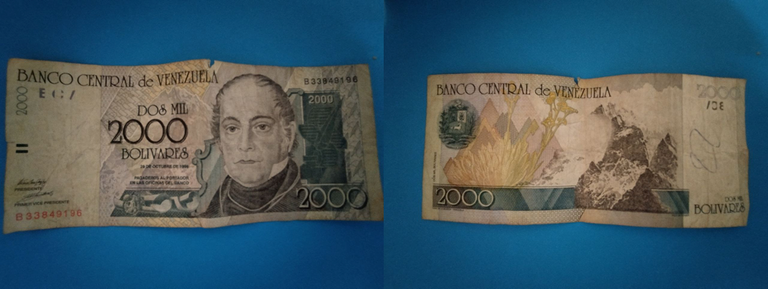
2000 bolívares shows the face of Andrés Bello and on the other side the Pico Bolívar, the Frailejón, and the national coat of arms.
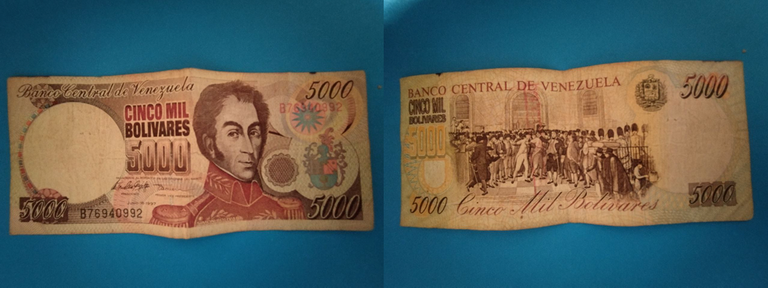
5000 bolívares has the face of Simón Bolívar and on the contrary, has another historical moment, the Declaration of Independence (April 19, 1810) and the national coat of arms.
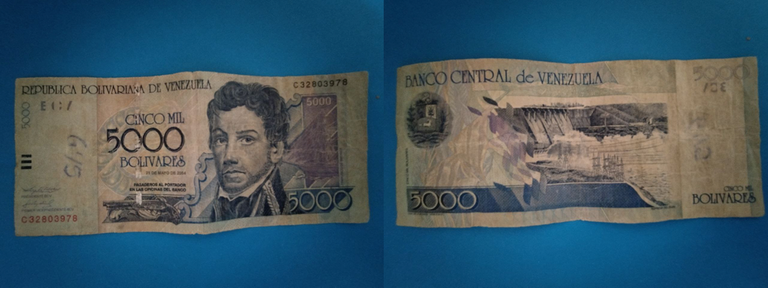
5000 bolívares have the face of Francisco de Miranda and the Guri Dam on the back and the national coat of arms.
As you can notice, this collection is missing the 10,000, 20,000, and 50,000 bolivar bills. As I mentioned, when the 1000 and 2000 bills were in circulation, the 10K, 20K and 50K bolivars were starting to come out. But, they ran into the reconversion and they decided not to include them in the new cone. It was expected that these bills, little by little as they were being used by the population, would be picked up by the banks and avoid their circulation again. Venezuelans were somewhat impressed that their currency was about to have a 100K bolivar bill.
In this cone is one of the banknotes that I have liked the most of all, the 1000 Bolivar bill in its red and white version. You can notice the watermarks on the bills as well. Something that I want to highlight of all these bills is the national coat of arms, which as you will see later with the other bills that I will be presenting to you, would suffer a change with respect to the bills that came later. I hope you notice it before I mention it.
I found this cone very interesting and you can see why. How the enumerations are repeated, there are two 1000 bills, two 2000 notes, and two 5000 notes, both in the same period. I understand that when thinking about the next monetary cone because of the lower denomination bills (5, 10, 20, 20, 50, 100, and 500) they were literally of no use (there was nothing you could buy with them) the bills that could be used the most were the 1000, 2000 and 5000. The intention was not to print any more of the previous cone, so, for this new one, they decided to print new 1000, 2000, and 5000 bills to keep them in the economy.
Subsequently, new banknotes with new denominations would be issued, but with the particularity that 3 zeros would be discounted. Thus, in 2008 we would say goodbye to the bolivar and the bolivar fuerte monetary cone would come into effect. Then, the 1000, 2000, and 5000 bills would become 1 BsF, 2 BsF and 5 BsF respectively. Of course, more bills and coins would enter into this arrangement.
In a future edition, I will be showing you the bills of the following cones that I have.
I hope you have enjoyed this part of the collection. If you want to be notified when the next part will be released, don't hesitate to let me know in the comments.

¡Saludos comunidad!
Un gusto compartir con ustedes nuevamente. Tengo pendiente con ustedes compartir algunos más de mis recuerdos. Pero, esta nueva colección que les estaré presentando viene siendo algo distinta.
Les presento nuestra colección de billetes de Venezuela
Si bien, un billete es algo de sumo uso por la sociedad, suele cambiar tanto y tan rápido que la única forma de verlos de nuevo es en un museo o en algunas colecciones particulares.

Pues bien, tener una colección de billetes puede ser relativamente fácil. En nuestro caso, sólo ha bastado con tomar alguno del uso rutinario, evitar su propósito, por ejemplo, no usarlo en un pasaje de bus, en una compra en el mercado o evitar pagar con él algún servicio y sólo guardarlo con otros.
Tal vez el único inconveniente de tratar de crear una colección como esta sería tratar de conseguir billetes que nunca llegaste a usar, billetes que tuvieron muy poca emisión, billetes de edición especial o por la antigüedad. Por ejemplo, el primer billete que se data en Venezuela es de 1811 los llamados “asignados” o el billete mirandino en honor a Francisco de Miranda quién sugirió la idea al reciente congreso venezolano establecido para darle un cierto orden económico a Venezuela que estaba viviendo un despertar revolucionario. Conseguir un billete así, sin duda debe ser algo sumamente difícil y no está al alcance de cualquier persona.
Sin embargo, creo que en particular encontrarán bien interesante la cantidad de billetes que mi país ha tenido en un lapso tan corto de unos 20 años aproximadamente. (sin incluir los billetes del actual cono monetario puestos en vigencia desde octubre del 2021)
Diciendo esto, quiero dejar en claro, que esta colección, aunque me gustaría presentarla completa, creo que es mejor dividirla en varias partes, para que resulte más amena y pueda analizar con detalle cada billete. El día de hoy les estaré presentando los primeros billetes que fueron almacenados y la semana que viene estaré presentándoles el resto de la colección.
Cuando me refiero a cono monetario, me estoy refiriendo a todos esos billetes que están o estuvieron en circulación en una sociedad. Por ejemplo, los reconocidos billetes y monedas de Estados Unidos, que trasciende fronteras que conocemos con las denominaciones de 1, 2, 5, 10, 20, 50 y 100 USD representan el actual cono monetario de Estados Unidos.
Si bien, no quiero hablar sobre detalles políticos ni nada por el estilo. La razón de que existieran tantos conos monetarios en Venezuela tiene que ver con la super inflación que este país ha vivido. La inflación ocurre en resumidas palabras, cuando el precio de los productos y servicios aumentan en deterioro de la moneda. Lo que se traduce como una disminución del poder adquisitivo del dinero.
La moneda de Venezuela es el Bolívar en honor a Simón José Antonio de la Santísima Trinidad Bolívar Ponte y Palacios Blanco (Simón Bolívar) uno de los próceres más importantes que influyó en el proceso independentista de Venezuela y algunos otros países de Sur y Centro América. El bolívar como moneda fue establecida en 1879 sólo en Venezuela.
Aunque no son los primeros billetes que tuvo Venezuela, los dos primeros billetes con los que se forma esta colección, que no recuerdo haberlos utilizado. Pero, tienen una historia bien peculiar, son los billetes de 1 y 2 bolívares.



Estos billetes, los llegaron a conocer como los “Tinoquitos” por el presidente en curso de la época (Pedro Tinoco) y por la simpleza que mostraban, también se les conoció como “Billetes de Monopolio” por el famoso juego. Surgieron en la economía venezolana casi por emergencia en 1989. La economía venezolana, al ser rica en minerales, cometió con algunas monedas, el error de añadir demasiado Níquel a la composición de la moneda, lo que las hacía más valiosa de lo que verdad eran. Los vecinos de Venezuela, emprendieron una campaña de tomar estas valiosas monedas y utilizarlas en su industria. Al existir escases de monedas, se tomó la decisión de darle luz a estos billetes. Valiosas monedas como éstas hubo varias en la historia de Venezuela.
El primer cono con el que me manejé de niño creo que fue el que más duró. Había monedas y billetes de una denominación bastante baja con lo que se podía hacer bastante. Aunque había monedas, en este post sólo les presentaré los billetes que conservamos. Tal vez luego, les muestre las monedas que poseemos.

Se puede ver a Simón Bolívar y Francisco de Miranda, en la parte de atrás está el Panteón Nacional con el escudo de Venezuela.

10 bolívares muestra a Simón Bolívar y Antonio José de Sucre en una cara del billete y el Panteón Nacional y el escudo de Venezuela en la otra.

20 bolívares es la figura de José Antonio Páez, el monumento del Panteón Nacional y el escudo de armas.


50 bolívares muestran la figura de Andrés Bello junto al Palacio de las Academias, en el reverso figura el Banco Central y el escudo de armas.

100 bolívares, con el rostro de Simón Bolívar y el Capitolio Nacional y el escudo nacional en el reverso.

500 bolívares tiene el rostro de Simón Bolívar, una orquídea y el escudo nacional en el reverso.

Los 1000 bolívares tienen la cara de Simón Bolívar y en el reverso un momento histórico (la Firma del Acta de Independencia, 5 de julio de 1811).

1000 bolívares tienen el rostro de Simón Bolívar y en el reverso aparecen el Panteón Nacional y el escudo nacional.

2000 bolívares muestran el rostro de Antonio José de Sucre y el Triunfo de Sucre en la Batalla de Ayacucho (9 de diciembre de 1824) y el escudo nacional.

2000 bolívares muestra el rostro de Andrés Bello y al otro lado el Pico Bolívar, el Frailejón y el escudo nacional.

5000 bolívares tiene el rostro de Simón Bolívar y por el contrario, tiene otro momento histórico, la Declaración de Independencia (19 de Abril 1810) y el escudo nacional.

5000 bolívares tienen en el reverso el rostro de Francisco de Miranda y la represa de Guri y el escudo nacional.
Como pueden notar, a esta colección le faltan los billetes de 10000, 20000 y 50000 bolívares. Cómo les mencioné, cuando los billetes de 1000 y 2000 estaban mucho en circulación, los billetes de 10K, 20K y 50K bolívares estaban empezando a salir. Pero, se toparon con la reconversión y decidieron no incluirlos en el nuevo cono. Se esperaba que estos billetes, poco a poco mientras eran usados por la población, fueran recogidos por los bancos y evitar su circulación nuevamente. El venezolano estaba algo impresionado porque su moneda estuviese a punto de tener un billete de 100K bolívares.
En este cono está uno de los billetes que más me ha gustado de todos, el billete de 1000 Bolívares en su versión en blanco y rojo. Pueden notar que en los billetes se presenta sus marcas de agua también. Algo que quiero resaltar de todos estos billetes es el escudo nacional, que como verán luego con los otros billetes que les iré presentando, sufriría un cambio respecto a los billetes que vinieron posteriormente. Espero lo noten antes de que lo mencione.
Este cono me pareció muy interesante y pueden notar el por qué. Cómo se repiten las enumeraciones, hay dos billetes de 1000, dos de 2000 y dos de 5000, ambos en el mismo período. Tengo entendido que cuando se está pensando en el siguiente cono monetario debido a que con los billetes de menor denominación (5, 10, 20, 50, 100 y 500) literalmente no eran de utilidad (no había nada que se pudiera comprar con ellos) los billetes que más se podían usar eran los de 1000, 2000 y 5000. La intención era no imprimir más del anterior cono, así que, para este nuevo, decidieron imprimir nuevos billetes de 1000, 2000 y 5000 para que siguieran en la economía.
Posteriormente se vendrían los nuevos billetes con nuevas denominaciones, pero con el particular de que serían descontados 3 ceros. Así, en el 2008 le diríamos adiós al bolívar y entraría en vigor el cono monetario del bolívar fuerte. Entonces los billetes de 1000, 2000 y 5000 pasarían a ser de 1 BsF, 2 BsF y 5 BsF respectivamente. Por supuesto, entrarían más billetes y monedas a este arreglo.
En una próxima edición les estaré mostrando los billetes de los siguientes conos que poseo.
Espero hayan disfrutado de esta parte de la colección. Si quieren que les notifique cuando salga la siguiente parte, no duden en hacérmelo saber en los comentarios